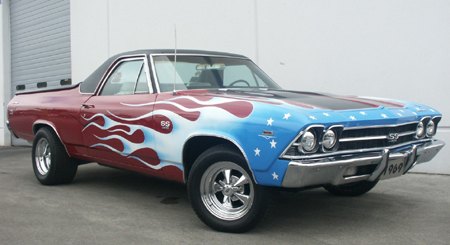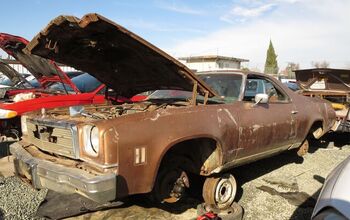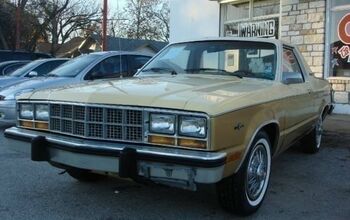El Camino Redux?
The Big 2.5 are floundering about, looking for new product ideas. And no wonder. Does anyone really think the beleaguered domestic automakers have the time, talent, energy and money to develop a Camcordima beater? A [profitable] B-segment car that can take on the Fit, Yaris or Versa? A luxury car to rival the Germans? As the founder of Federal Express said, the trick in business is not to do something a little better than the other guy. The trick is to do something different. Anybody remember the El Camino?
The iconic Chevrolet El Camino– half car, half truck– arrived in ’59. The original was based a full-sized Chevrolet Impala, sidewise tailfins and all. In 1964, the El Camino returned from hibernation as a variant of the mid-sized Chevelle/Malibu in ‘64. In ’68, the El was joined by the GMC Sprint, complete with an optional LS6 V8.
As “real” trucks increased in popularity, sales of the GM twins dwindled. Twenty years ago, after producing some 537k "elcos," GM pulled the plug on the Caballero (nee Sprint).
The El Camino was preceded and then mirrored by the Ford Ranchero. From ’57 onwards, the Ranchero’s development followed a similar theme, evolving atop the Fairlane, Falcon, Torino and Thunderbird/LTD platforms. The Ranchero faded from the scene in the mid-‘70’s, probably slinking off the automotive stage from the sheer embarrassment of having to wear imitation wood siding like a Country Squire.
There have been more than a few attempts at a nouveau camino. Most prominently, Subaru offered US consumers the BRAT (Bi-drive Recreational All-terrain Transport) and Baja (which bowed out last April). Chrysler served-up the Dodge Rampage and Plymouth Scamp (based on the Omni/Horizon platform). It must be said that none of these models set the American sales charts on fire.
The Honda Ridgeline is, perhaps, the only remaining modern equivalent, and it's WAY too ugly to consider a bona fide member of the "elco" family. Of course, the minivan platform sharing Ridgeline is [officially] a truck, which points to one of the main reasons why the El Camino disappeared from the scene.
When federal CAFE standards were introduced in ’75, the emissions and mileage requirements were far tougher on cars than “light trucks." A burgeoning selection of small pickups (e.g. the Ford Ranger) helped put the last nails in the El Camino's coffin compatible coffin.
New CAFE legislation bases required mileage on a given vehicle’s footprint, rather than averaging out an entire fleet. So, while trucks are still less hampered than cars, an El Camino shaped door has opened. The fact that Ford has completely neglected the Ranger and Dodge has supersized the Dakota only helps matters.
Ford has all the ingredients in its corporate cupboard to resurrect the concept. The Mustang needs only a little rework from the driver’s seat back. Use the same doors, quarter panels and rear floor; chop the roof, add a vertical window and the interior of the load bed, and there you have it. (The ‘Stang’s “antiquated” rear axle would become a genuine advantage/selling point for load luggers.)
For less than FoMoCo pays Carroll Shelby to sign a few autographs, a Ford is born. Call it the Ranchero and brag that it’s the fastest pickup on the market. That would spike up Mustang sales, just in time to help fight off the two C’s (Camaro and Challenger).
Chrysler could also resurrect the genre. The 300/Magnum/Charger platform is rear wheel-drive (a must if a truck is to have any kind of macho credentials) with a wide variety of engine choices. Of these, the Magnum is the best candidate for “caminoization.
Since it was designed as a station wagon (despite whatever DCX wants to call it), the Dodge Magnum already has the required length. Get rid of the back doors, truncate the roof (but keep the “chopped” appearance), and finish off the bed. Voila! Instant niche vehicle. While they’re at it, DCX should reinforce the chassis a bit and offer a towing package. With the Hemi, the Magnamino could easily pull ski boats, jet skis and small camping or utility trailers.
FoMoCo and DCX will have to move fast if they want to be the first on the retro elco block. GM is set to import their Australian division's Holden Commodore as the new Pontiac G6. Holden sells an El Camino-like variant called the Ute that's just begging for an American passport (both the paper and the radar detector). If they don’t badge it a Chevy and sell it as an El Camino, I'm going home. And yet…
The Chevrolet SSR reminds us that niche vehicles are a risky business. But the Big 2.5 have their collective backs against the wall. If they make a few low-cost bold moves sideways, they just might find some of the new product salvation they seek.
More by Bob Elton
Latest Car Reviews
Read moreLatest Product Reviews
Read moreRecent Comments
- Kjhkjlhkjhkljh kljhjkhjklhkjh A prelude is a bad idea. There is already Acura with all the weird sport trims. This will not make back it's R&D money.
- Analoggrotto I don't see a red car here, how blazing stupid are you people?
- Redapple2 Love the wheels
- Redapple2 Good luck to them. They used to make great cars. 510. 240Z, Sentra SE-R. Maxima. Frontier.
- Joe65688619 Under Ghosn they went through the same short-term bottom-line thinking that GM did in the 80s/90s, and they have not recovered say, to their heyday in the 50s and 60s in terms of market share and innovation. Poor design decisions (a CVT in their front-wheel drive "4-Door Sports Car", model overlap in a poorly performing segment (they never needed the Altima AND the Maxima...what they needed was one vehicle with different drivetrain, including hybrid, to compete with the Accord/Camry, and decontenting their vehicles: My 2012 QX56 (I know, not a Nissan, but the same holds for the Armada) had power rear windows in the cargo area that could vent, a glass hatch on the back door that could be opened separate from the whole liftgate (in such a tall vehicle, kinda essential if you have it in a garage and want to load the trunk without having to open the garage door to make room for the lift gate), a nice driver's side folding armrest, and a few other quality-of-life details absent from my 2018 QX80. In a competitive market this attention to detai is can be the differentiator that sell cars. Now they are caught in the middle of the market, competing more with Hyundai and Kia and selling discounted vehicles near the same price points, but losing money on them. They invested also invested a lot in niche platforms. The Leaf was one of the first full EVs, but never really evolved. They misjudged the market - luxury EVs are selling, small budget models not so much. Variable compression engines offering little in terms of real-world power or tech, let a lot of complexity that is leading to higher failure rates. Aside from the Z and GT-R (low volume models), not much forced induction (whether your a fan or not, look at what Honda did with the CR-V and Acura RDX - same chassis, slap a turbo on it, make it nicer inside, and now you can sell it as a semi-premium brand with higher markup). That said, I do believe they retain the technical and engineering capability to do far better. About time management realized they need to make smarter investments and understand their markets better.


































Comments
Join the conversation
The El Camino works for some because its a ridiculous example of a bygone era. An automotive monstrosity that's so ugly that it turns heads and makes desire flutter. I want a real El Camino not because of its perceived usefulness, but the sheer uselessness of the thing. I wouldn't look twice at a "new El Camino." I'd scorn it, like the Subaru Baja, as a stupid answer to a question no one asked.
Some of us grew up with El Camino's and Ranchero's everywhere, before SUV'S. I own a El Camino and I use it as a Truck, and It Drives like a car...My Jeep Grand Cherokee can't even come close...So us Mullet wearing 70's loving people still are out there, and If they brought back the El Camino or even the Falcon from Australia, we would buy it....Besides pulling up to a honda and the kids revs his toy eng, and my 454 takes off,,,What can you say....Movair